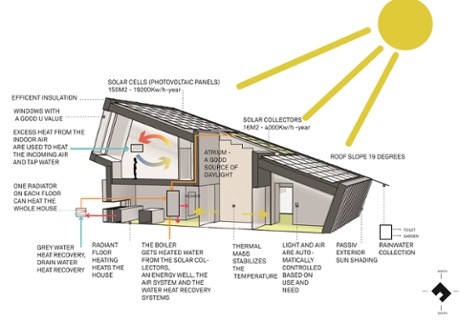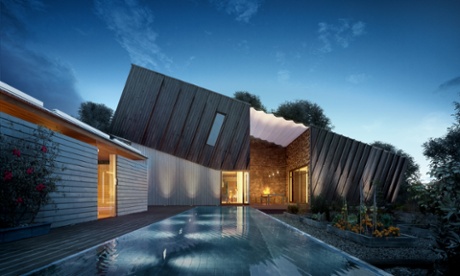The way we live now: the rise of the energy-producing home
Imagine living in a house that contributed to society: a house that produced energy, while consuming none itself. Well, imagine no more. After perfecting the “passivhaus”, which consumes minimal energy, engineers and architects have developed the energy positive house.
Generating energy is one thing, building a house is another. But with its plant-decorated walls and enormous double-glazed windows, the ArchiBlox Positive House, introduced in Melbourne’s City Square last month, looks elegant and modernist. “The trick is to make the sustainable and performance products visually pleasing while also practical,” reports David Martin, construction director of the ArchiBlox Positive House – the world’s first pre-fab energy positive house.
Rooftop solar panels and cooling tubes generate energy and regulate the temperature, while double-glazed windows and thick walls conserve energy. The end result: surplus power.

The ArchiBlox team is not alone in successfully completing the energy positive challenge. The German city of Königsbrunn, working in collaboration with the Augsburg University of Applied Sciences and a local gas and electricity company, is finalising the cube-like Visioneum in the central square, where city officials hope its presence will inspire residents to think about their household energy consumption.
At the University of California, Berkeley, students working in collaboration with Honda have developed yet another concept, the Honda Smart Home, which looks more like a typical terraced house, but which generates surplus energy the same way as the ArchiBlox and the Visioneum: by radically conserving it while generating more than it needs though solar panels.
Students at the Delft University of Technology, meanwhile, have invented a highly innovative “skin” that can be attached to existing houses with similar results. And in Norway, architecture firm Future Built has managed to turn two ordinary office buildings into energy-generating ones, cutting their energy use by 90% through additional insulation and the use of sensors to control light and heating. Here, too, solar panels on the roof provide energy that can be sold back to the grid.
With cars and homes accounting for 44% of greenhouse gasses in United States (and similar percentages in Europe), it’s no surprise that researchers and architects are trying to find ways of making homes more energy-efficient.
“The development of smart technologies, like the Google Nest, is making energy savings more convenient for users by allowing for control over temperatures in the house while you are away from the house, and allowing temperatures to follow your daily routines”, notes Esben Alslund-Lanthén, an analyst at the Danish sustainability thinktank Sustainia.

Kristian Edwards says building a plus-house is technically straightforward. “We calculated how many square meters of solar panels we needed and optimised the angle of the roof to get maximum solar yield,” he reports. “But plus-houses are also about minimising energy consumption, so we used as much recycled material as possible, such as whole bricks from a barn nearby.” With its box-like wooden top floor slanted over the lower floor for maximum sun exposure, Snøhetta’s experiment – the ZEB Multi-Comfort House, located in the Norwegian city of Larvik – boasts a visually striking appearance.
There’s just one thing: the cost. “Cost is always a factor when building houses that are taking advantage of the newest technology”, notes Alslund-Lanthén. “Plus-houses will likely remain more expensive than conventional houses, but on the other hand the owners will benefit from lower utility bills throughout the lifetime of the house, and in many cases from added benefits such as a better indoor climate due to improved ventilation, more daylight and better insulation.”
But Edwards, an architect at the Snøhetta architechture firm in Oslo, argues that plus-houses don’t have to be expensive, noting that a ZEB-style house may only cost 25% more to build than a similar, newly-designed home. The dropping cost of photovoltaic cells will also aid the advance of plus-houses.
Either way, utility companies are currently developing new payment models that will allow home owners to pay back the cost of the new technologies through energy savings. Other plus-house owners may opt to sell their surplus energy to the grid. At the ZEB house, in turn, surplus energy will power the electric car that future residents may own.
What’s life in a plus-house like? Norwegian families have volunteered to test the ZEB house for three months each and will report their findings to Edwards and his Snøhetta colleagues. And David Martin is about to find out for himself, having signed up to live in his ArchiBlox construction with his young family for the next 24 months.
The technology and innovation hub is funded by BT. All content is editorially independent except for pieces labelled “brought to you by”. Find out more here.
Join the community of sustainability professionals and experts. Become a GSB member to get more stories like this direct to your inbox.
guardian.co.uk © Guardian News & Media Limited 2010
Published via the Guardian News Feed plugin for WordPress.